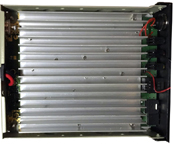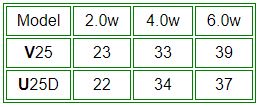 Review – BTech AMP-25 series for Analog & DMR
Review – BTech AMP-25 series for Analog & DMR
The AMP-25 series VHF / UHF Amplifiers
The recently announced BTech Digital and Analog amplifier series puts a whole new spin on mobile operation. It performs more like a mobile than it does a power amp. The D series are true TDMA Tier2 DMR amplifiers.
Note: This review was done using an Anytone D868UV on both DMR and analog.
In the Box
Included with the 40W Mobile Amp are:
– Mounting Bracket
– 3′ Interface Control Cable (Kenwood K1 connectors)
– 3′ RF connect cable (SMA-M to SMA-F)
– Microphone and Hanger
– All necessary mounting hardware
– User Guide
General Description
– UHF or VHF Power Amplifier
– 2-6W > 20-40W Output
Modes of operation include:
| V25 U25 | V25D U25D |
| Analog (FM) C4FM (Fusion) P25 (Phase 1) NXDN IDAS dPMR MPT1327 | > DMR Tier II (TDMA) > P25 (Phase 2) Analog (FM) C4FM (Fusion) P25 (Phase 1) NXDN IDAS dPMR MPT1327 |
A Different type of Mobile Amplifier
I found these to be much more than a typical power amplifier. Although they can function as a simple ‘In and Out’ power amp, this is about as close to a full mobile as you can get. Although the driving  force was my DMR handheld sitting in my cup holder, the transmit audio was that of the included hand microphone and the receiver audio out was coming through the built in speaker driven by a four watt audio amplifier.
force was my DMR handheld sitting in my cup holder, the transmit audio was that of the included hand microphone and the receiver audio out was coming through the built in speaker driven by a four watt audio amplifier.
Transmit Power
I tested the power on two different models. The VHF V25 (non TDMA) and the U25D for UHF DMR. The power was tested using the analog side of both into a calibrated Bird Termaline wattmeter. The maximum current drain from my 13.6V 30A power supply was just under 6A. This is low enough for the amp to be powered by the 10A accessory jack in your vehicle.
Enclosure
The basic frame measures 4.6″W x 1.3″H x 5.5″D (excluding the SO-239) and weighs in at 26oz. I was curious to see the internal layout of the amp and to no surprise, there was a 5/8″ finned heat sink spanning the entire length and width of the case along with air vent along the back of the enclosure.
curious to see the internal layout of the amp and to no surprise, there was a 5/8″ finned heat sink spanning the entire length and width of the case along with air vent along the back of the enclosure.
Operating Modes
These are single band amplifiers.
V25(D) = VHF 136-174MHz
U25(D) = UHF 400-480MHz.
Note: The V25D and U25D were designed to include DMR Tier II (TDMA) and P25 Phase 2 along with all other modes. Their operation varies slightly.
V25 / U25
To operate VHF through the UHF (U25) amplifier, or UHF through the VHF (V25) amplifier, simply power off the amplifier. This will allow you to run straight through directly to the antenna without power amplification on that band.
V25D / U25D
These amplifiers will only operate within their specified VHF or UHF range. This is due to the circuit switching design of DMR Tier II and P25 Phase 2.
Hook Up
The simplest configuration is using the included RF cable to attach the radio to the amp. You could add a Spkr/Micr to the handheld, but you would still be bypassing some of the best features.
I use the two included cables. The 3′ RF cable to attach the radio to the amp, and the control cable. This allows me to use the full size hand microphone as well as connecting the four watt audio amp powering the speaker. The power included power cable is compatible with handhelds using the standard two pin Kenwood style connector, such as an MD380, D868, GD77, UV5R, F8HP, UV82, etc.
allows me to use the full size hand microphone as well as connecting the four watt audio amp powering the speaker. The power included power cable is compatible with handhelds using the standard two pin Kenwood style connector, such as an MD380, D868, GD77, UV5R, F8HP, UV82, etc.
I use an Anytone D868 on DMR as well as analog with the hookup diagrammed below. Depending on your radios antenna jack, you may need to pickup an SMA-M to SMA-M adapter.
Convenience
All channel selection and volume adjustments are done using the handheld. No duplicate programming or code plugs are necessary. Whatever is in my handheld is what I operate in the mobile
Operating my handheld in the low power position, I still get 22W out on UHF and my handheld’s battery life remains excellent, but high power gives me a solid 39W.
Conclusion
I was glad to see someone finally develop what is a full featured mobile amplifier capable of DMR as well as all other modes including C4FM and D-Star that is small enough to mount in the car, boat, and on top of your computer. This amplifier is Part 90 certified and definitely worth considering.
Available from Amazon: V25 V25D U25 U25D
and ![]()

VHF /UHF
Digital / Analog
Mobile Power Amplifiers
![]()
![]()

















I will be ordering mine Friday,Love the review
So this is a “Real” review? I don’t think so. Where are the (at an absolute minimum) spectrum analyzer plots of the spurious and/or other unwanted output products? Remember: TMDA unwanted signal measurement is FAR from simple to do properly (there’s always a trade-off between time and frequency-domain resolution). The simplest measurement would require a narrow harmonic filter followed by a fast-acting asynchronous sample and hold peak power detector with the output statistically sampled. Then there’s the calibration of the whole setup – especially the time-domain response of the detector and the directional coupler. This is the problem with the MIKLOR site IMO. All “Reviews” of these Chinese products should come with spectral analysis of unwanted outputs. These amplifiers are selling for roughly $100. Remember the very cheap Chinese radios from the same manufacturer that might drive these amps are NOTORIOUS for spurs and unwanted output signals. So why would we expect this to change when it comes to these “Amplifiers”?
When I found out about this amp, I jumped at the opportunity to pick one up as it seemed to fit a need I had for a better set up for the shack and allow me to use my TYT MD380 handheld, with better speaker audio and more power rather than having it just sit around.
I bought one on Amazon and it arrived in two days.
I set it up and tried it on a local UHF repeater, using a Parrot feature, which allows users to hear their audio playback. I noticed a pulsing on the audio, which seemed to a function of the DMR amp switching on and off coincident to the time slot. I tried a number of things, like ferrite rings on the power cable, the interface cable and even the mic cord, but none of that resolved the problem. I tried it in the car as well and even wrapped the radio in foil to see if that had any effect. The problem persisted.
During this time I have had multiple emails with Baofeng Tech support. They have been extremely responsive with suggestions and recommendations to aid in resolving the problem. They sent another unit to me, it did the same thing. I don’t have another DMR handheld to try, as they indicated it might be the radio. Well, I can’t rule that in or out. However, the amp unit works perfectly in a conventional fashion, meaning using the HT to key the amp, even when using an external speaker mic on the radio. No noise. So I have difficulty pointing at the radio. I experience the noise when the interface cable plugs between the radio and the amp suspecting RF is on the cable or noise on the audio into the radio.
I’m not keeping the unit as I cannot use it with its built in amplified speaker and handheld mic features. I hope one of these amps work for you as its a cool device.
So what happens when I send 8 amps from my Baofeng UV82-HP into this thing?
Hopefully nothing but could it cause damage in the long run?
Odd no one mentions this as it is likely to hapen.
@Joe KDoZBM, I think you mean 8 WATTS from your UV82-HP. Pulling 8 AMPS from your handheld (whos battery is 7.4V nominal) would be over 50 Watts